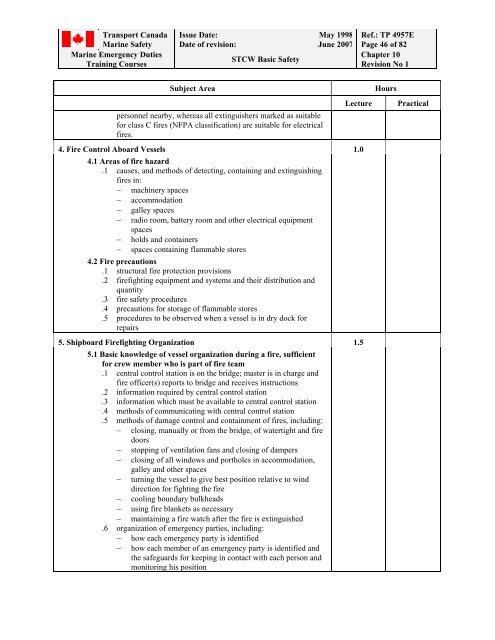MARINE EMERGENCY DUTIES - Transport Canada
MARINE EMERGENCY DUTIES - Transport Canada
MARINE EMERGENCY DUTIES - Transport Canada
Create successful ePaper yourself
Turn your PDF publications into a flip-book with our unique Google optimized e-Paper software.
<strong>Transport</strong> <strong>Canada</strong><br />
Marine Safety<br />
Marine Emergency Duties<br />
Training Courses<br />
Issue Date: May 1998<br />
Date of revision: June 2007<br />
STCW Basic Safety<br />
Ref.: TP 4957E<br />
Page 46 of 82<br />
Chapter 10<br />
Revision No 1<br />
Subject Area Hours<br />
personnel nearby, whereas all extinguishers marked as suitable<br />
for class C fires (NFPA classification) are suitable for electrical<br />
fires.<br />
4. Fire Control Aboard Vessels 1.0<br />
4.1 Areas of fire hazard<br />
.1 causes, and methods of detecting, containing and extinguishing<br />
fires in:<br />
− machinery spaces<br />
− accommodation<br />
− galley spaces<br />
− radio room, battery room and other electrical equipment<br />
spaces<br />
− holds and containers<br />
− spaces containing flammable stores<br />
4.2 Fire precautions<br />
.1 structural fire protection provisions<br />
.2 firefighting equipment and systems and their distribution and<br />
quantity<br />
.3 fire safety procedures<br />
.4 precautions for storage of flammable stores<br />
.5 procedures to be observed when a vessel is in dry dock for<br />
repairs<br />
5. Shipboard Firefighting Organization 1.5<br />
5.1 Basic knowledge of vessel organization during a fire, sufficient<br />
for crew member who is part of fire team<br />
.1 central control station is on the bridge; master is in charge and<br />
fire officer(s) reports to bridge and receives instructions<br />
.2 information required by central control station<br />
.3 information which must be available to central control station<br />
.4 methods of communicating with central control station<br />
.5 methods of damage control and containment of fires, including:<br />
− closing, manually or from the bridge, of watertight and fire<br />
doors<br />
− stopping of ventilation fans and closing of dampers<br />
− closing of all windows and portholes in accommodation,<br />
galley and other spaces<br />
− turning the vessel to give best position relative to wind<br />
direction for fighting the fire<br />
− cooling boundary bulkheads<br />
− using fire blankets as necessary<br />
− maintaining a fire watch after the fire is extinguished<br />
.6 organization of emergency parties, including:<br />
− how each emergency party is identified<br />
− how each member of an emergency party is identified and<br />
the safeguards for keeping in contact with each person and<br />
monitoring his position<br />
Lecture Practical

















